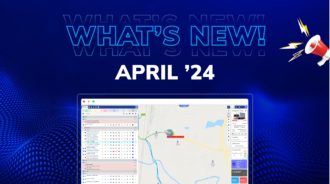In today’s fast-paced business world, the efficiency of job dispatch plays a crucial role in the success of fleet management operations. The advancement in job dispatch software has revolutionized how companies assign, manage, and track their field tasks. However, with numerous options available in the market, choosing the right software can be overwhelming. In this comprehensive guide, we will delve into the top 5 key features to look for in job dispatch software, aligning them with the latest trends and best practices in fleet management.
What is Job Dispatch Management Software?
Job Dispatch Management Software refers to a digital tool designed to streamline and optimize the process of assigning, scheduling, and managing tasks, especially for businesses that operate with field workers or mobile teams, such as delivery services, repair and maintenance crews, transportation fleets, and more. This software plays a crucial role in enhancing the efficiency, responsiveness, and overall management of field operations. Here’s a detailed breakdown of what job dispatch management software is and how it works:
Definition and Core Functions
- Task Assignment and Scheduling:
- Automated Dispatch: Automatically assigns tasks to the most suitable employee based on various factors like location, skill set, and availability.
- Dynamic Scheduling: Adjusts schedules in real-time to accommodate changes, delays, or emergencies.
- Real-Time Communication and Updates:
- Instant Messaging: Enables instant communication between dispatchers and field agents.
- Status Updates: Provides real-time updates on task progress, completion, and any issues encountered.
- GPS and Route Optimization:
- Location Tracking: Tracks the real-time location of field agents using GPS.
- Route Planning: Calculates the most efficient routes to minimize travel time and fuel consumption.
Advanced Features
- Integration Capabilities:
- Seamlessly integrates with other business software systems, such as CRM, ERP, and inventory management, for a unified workflow.
- Customization and Scalability:
- Allows customization to fit specific business needs and scales as the business grows.
- Data Analytics and Reporting:
- Provides valuable insights through data analysis and detailed reports on performance metrics.
Benefits of Dispatch Software in Fleet Management
- Increased Efficiency: Reduces idle time, improves job completion rates, and minimizes manual scheduling efforts.
- Enhanced Customer Satisfaction: Improves response times and service quality, leading to better customer experiences.
- Cost Reduction: Lowers operational costs by optimizing routes and reducing administrative workload.
- Better Decision Making: Offers data-driven insights for strategic planning and resource allocation.
Industry Applications
- Transportation and Logistics: For managing delivery schedules and routes.
- Utilities and Maintenance Services: For dispatching repair and maintenance tasks.
- Healthcare Services: For scheduling and managing home visits and patient transport.
- Field Service Management: For technicians and professionals who provide on-site services like installations, repairs, or inspections.
Trends and Future Outlook
- AI and Machine Learning Integration: Incorporating AI to predict demand, allocate resources more efficiently, and provide smarter scheduling.
- IoT Integration: Leveraging Internet of Things (IoT) for better asset tracking and condition monitoring.
- Enhanced Customization: Offering more tailored solutions to meet the specific needs of various industries.
- Focus on Sustainability: Optimizing routes and schedules to reduce carbon footprint and promote eco-friendly practices.
Choosing the Right Software
When selecting job dispatch management software, businesses should consider factors such as ease of use, integration capabilities, customization options, scalability, and the level of support provided by the vendor. It’s also important to evaluate the software based on specific business needs, size, and industry requirements.
5 Key Features to Look for in Job Dispatch Software
1. Real-Time Tracking and Updates
Real-time tracking is a fundamental feature of any job dispatch software. It allows fleet managers to monitor the exact location of their vehicles and staff in real time. This feature not only enhances the efficiency of operations but also ensures customer satisfaction through timely updates. Real-time tracking helps in:
- Minimizing Delays: Quick identification and resolution of issues that may cause delays.
- Improving Customer Service: Providing customers with accurate arrival times and status updates.
- Enhancing Accountability: Keeping track of employee productivity and vehicle usage.
2. Automated Scheduling and Dispatching
The heart of job dispatch software lies in its ability to automate scheduling and dispatching. This feature saves significant time and reduces human error. Automated scheduling involves:
- Intelligent Task Allocation: Assigning jobs based on proximity, availability, and skill set.
- Efficiency in Operations: Reducing idle time and ensuring optimal use of resources.
- Scalability: Easily managing an increase in workload without the need for additional staff.
3. Seamless Integration Capabilities
For maximum effectiveness, job dispatch software should seamlessly integrate with your existing fleet management systems. Integration facilitates:
- Data Consolidation: Bringing together data from different sources for better decision-making.
- Process Simplification: Streamlining operations by reducing the need for multiple platforms.
- Enhanced Analytics: Providing comprehensive insights for strategic planning and optimization.
4. Customization and Flexibility
Every business has unique needs. Therefore, customization and flexibility in software are essential. This includes:
- Tailored Features: Adapting the software to fit specific business processes and requirements.
- Scalable Solutions: Accommodating business growth and changes without the need for a software overhaul.
- User-Friendly Interface: Ensuring ease of use for all levels of tech-savviness within your team.
5. Robust Reporting and Analytics
Data is king in today’s data-driven world. Robust reporting and analytics capabilities in job dispatch software empower businesses to:
- Track Key Metrics: Monitoring performance indicators such as response times, job completion rates, and customer satisfaction.
- Make Informed Decisions: Utilizing data for strategic planning and resource allocation.
- Identify Trends: Spotting patterns and opportunities for improvement in operations.
Conclusion
Selecting the right job dispatch software is a strategic decision that can significantly impact your fleet management efficiency. By focusing on these five key features – real-time
tracking and updates, automated scheduling and dispatching, seamless integration capabilities, customization and flexibility, and robust reporting and analytics – businesses can ensure they choose a solution that not only meets their current needs but also supports future growth and adaptation.
Remember, the effectiveness of job dispatch software is not just in its features but in how well it aligns with your operational processes and goals. It’s essential to choose a solution that integrates with your advanced fleet management software, enhancing overall efficiency and productivity.
In conclusion, as we navigate the evolving landscape of fleet management, the role of job dispatch software becomes increasingly significant. By prioritizing these key features and staying informed about the latest trends, businesses can leverage technology to streamline their operations, improve customer satisfaction, and drive growth. The future of fleet management is here, and it’s powered by smart, adaptable, and efficient job dispatch solutions.
Embracing the Future with Smart Job Dispatch Software
As we wrap up this detailed exploration of job dispatch software, it’s clear that embracing these technological advancements is not just a choice but a necessity for businesses looking to thrive in the competitive landscape of fleet management. The integration of real-time tracking, automated processes, seamless system integration, customizable solutions, and data-driven analytics is transforming how businesses operate, making them more agile, responsive, and customer-focused.
The future is all about smart solutions that adapt to your business needs, providing you with the tools to make informed decisions, optimize resources, and stay ahead of the curve. By choosing the right job dispatch software, you are not just investing in a tool; you’re investing in the future of your business.
Thank you for joining us on this journey through the world of job dispatch software. We hope this guide has provided you with valuable insights and considerations to help you make the best choice for your fleet management needs. Remember, the right software is out there, ready to take your business to new heights of efficiency and success.



